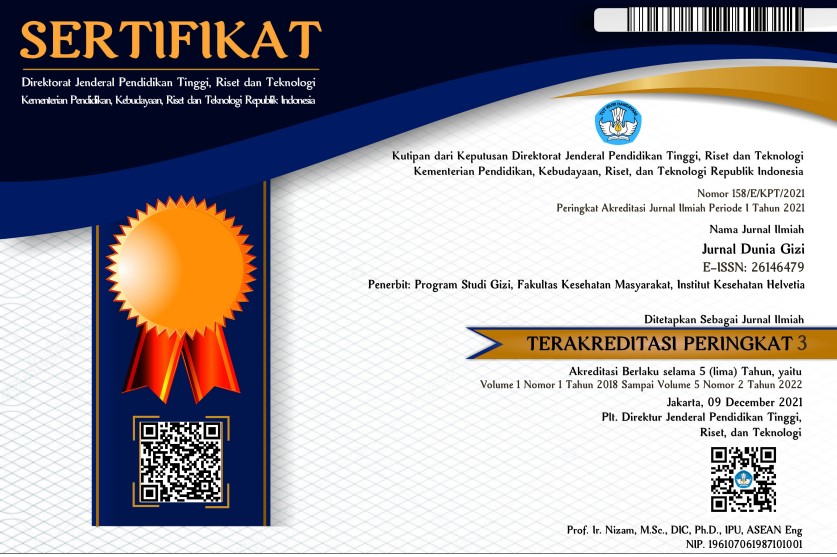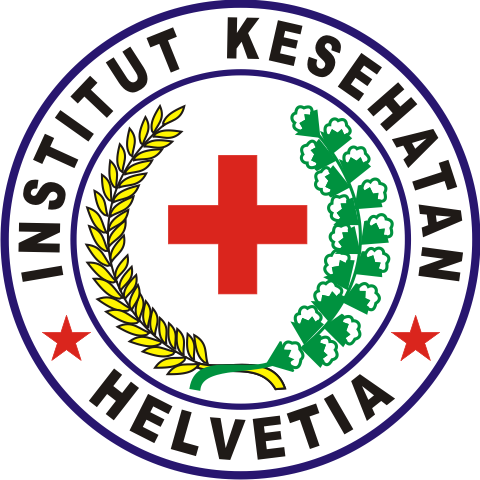Glycemic Index Meals of Anaerobic Shuttle Test in Endurance Badminton Athletes
Abstract
Keywords
Full Text:
PDFReferences
Sukarmin Y, Jurusan D, Kesehatan P, Fik R. Cedera Olahraga Dalam Perspektif Teori Model Ekologi. Medikora. 2005;1:11–22.
Parwata IMY. Kelelahan dan Recovery dalam Olahraga. J Pendidik Kesehat Rekreasi. 2015;1:2–13.
Oborne DJ. Ergonomic at Work: Human Factors in Design an Development. Thirth. England: West Sussex; 1995.
Suma’mur PK. Higiene Perusahaan dan Kesehatan Kerja. Jakarta; 1990.
Guyton ACJFH. Buku Ajar Fisiologi Kedokteran. 9th ed. Dkk. AB dr. IS, editor. Jakarta: EGC; 1997.
Tecky Indriana. Pengaruh Kelelahan Otot Terhadap Ketelitian Kerja. Stomatognatic. 2010;7(3):49–52.
Miles JM. A role for the glycemic index in preventing or treating diabetes ? 1 , 2. 2008;1–2.
Mondazzi L, Arcelli E. Journal of the American College of Nutrition Glycemic Index in Sport Nutrition Glycemic Index in Sport Nutrition. 2013;(November 2014):37–41.
Shuttleworthk M. What is a Repeated Studies Design ? Repeated Measures Designs - Crossover Studies. 2009;5–7.
Atkinson G, Nevill AM. Measurement Error ( Reliability ) in Variables Relevant to Sports Medicine. 1998;26(4):217–38.
Wolever T JD. The use of the glycemic blood glucose response. J Sci Med Sport. 1986;43(January):167–72.
Hargreaves M, Hawley JA, Jeukendrup A. Pre-exercise carbohydrate and fat ingestion : effects on metabolism and performance Pre-exercise carbohydrate and fat ingestion : effects on metabolism and performance. 2012;37–41.
Thomas C, Plowman SA, Marilyn A. Measurement in Physical Education and Exercise Science Reliability and Validity of the Anaerobic Speed Test and the Field Anaerobic Shuttle Test for Measuring Anaerobic Work Capacity in Soccer Players. 2009;(December 2014):37–41.
Brevi Istu Pambudi. Pengaruh Pemberian Makanan Indeks Glikemik Tinggi dan Rendah Terhadap Kelelahan Otot Atlet Badminton. Universitas Gadjah Mada Yogyakarta; 2013.
Dewi EK KM. Hubungan Asupan Zat Gizi Makro dan Status Gizi Terhadap Kebugaran Atlet Bulutangkis Jaya Raya Pada Atlet Laki-Laki Dan Perempuan di Asrama Atlet Ragunan Tahun 2013. EJurnal Nutr Diaita. 2013;5.
Wee S, Williams C, Tsintzas K, Boobis L, Williams C, Tsintzas K. Ingestion of a high-glycemic index meal increases muscle glycogen storage at rest but augments its utilization during subsequent exercise. 2005;707–14.
Febbraio MA, Keenan J, Angus DJ, Campbell SE, Garnham P, Febbraio MA, et al. Preexercise carbohydrate ingestion , glucose kinetics , and muscle glycogen use : effect of the glycemic index Preexercise carbohydrate ingestion , glucose kinetics , and muscle glycogen use : effect of the glycemic index. 2013;1845–51.
Laparidis K, Volaklis KA, Douda HT, Tokmakidis SP. The Effects of Pre-Exercise Glycemic Index Food on Running Capacity The E ff ects of Pre-Exercise Glycemic Index Food on Running Capacity. 2011;(May).
Moore LJS, Midgley AW, Thurlow S, Thomas G, Mc LR. Effect of the glycaemic index of a pre-exercise meal on metabolism and cycling time trial performance. 2010;13:182–8.
Wong SHS, Siu PM, Lok A, Chen YJ, Morris J, Lam CW. Effect of the glycaemic index of pre-exercise carbohydrate meals on running performance running performance. 2008;1391.
Wu C, Williams C. A Low Glycemic Index Meal Before Exercise Improves Endurance Running Capacity in Men. 2006;510–27.
Kirwan JP, Biomedical P, Gorman DJO, Yarasheski KE, Evans WJ. Effects of a moderate glycemic meal on exercise duration and substrate utilization. 2001;(October).
KL FM and S. CHO feeding before prolonged exercise: effect of glycemic index on muscle glycogenolysis and exercise performance. J Appl Physiol. 1996;
Thomas DE, Brotherhood JR, Brand JC. Carbohydrate Feeding before Exercise : Effect of Glycemic Index. 1991;12(25):180–6.
Jamurtas AZ, Deli CK, Georgakouli K, Fatouros IG. Chapter 2 - Glycemic Index, Food Exchange Values, and Exercise Performance. Second Edi. Nutrition and Enhanced Sports Performance. Elsevier Inc.; 2019. 11–29 p.
DOI: https://doi.org/10.33085/jdg.v2i2.4560
Refbacks

This work is licensed under a Creative Commons Attribution-NonCommercial 4.0 International License.









1.png)







.png)










